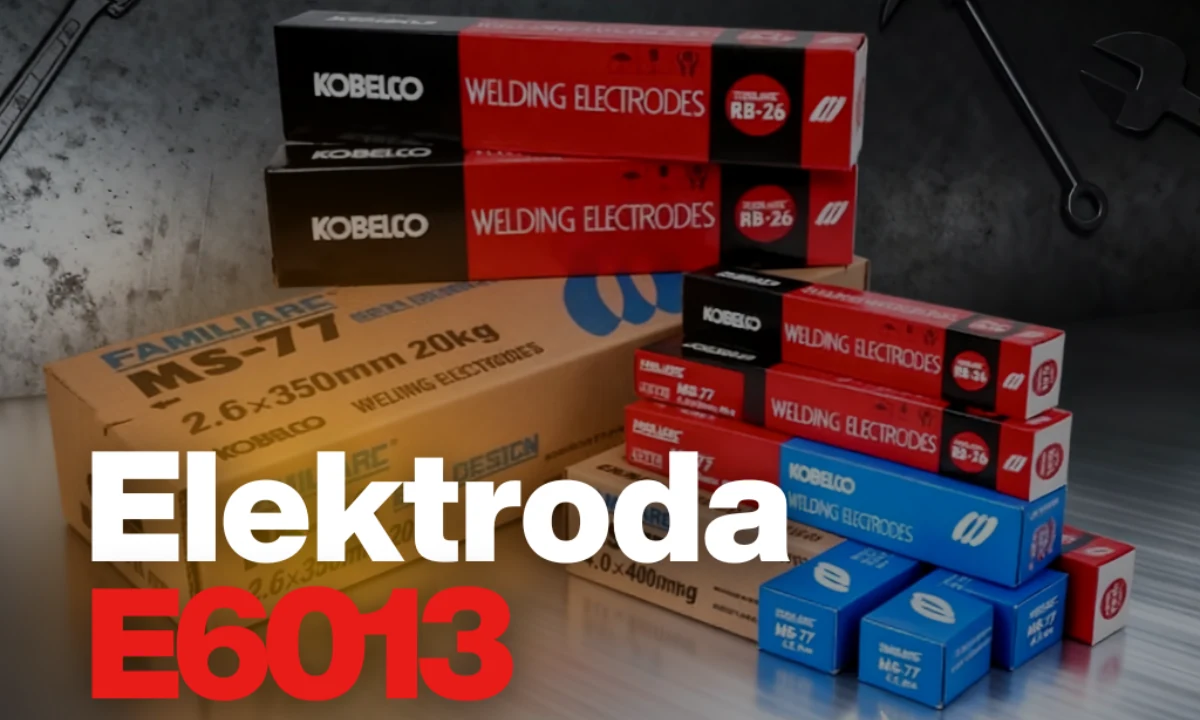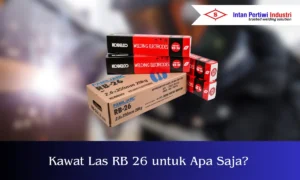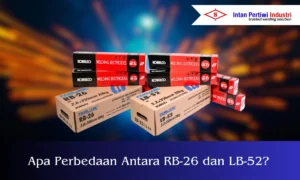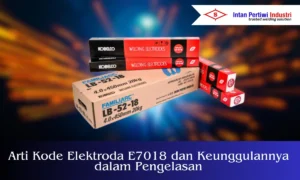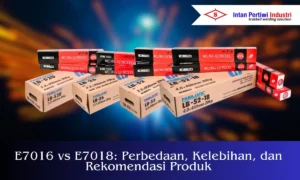E6013 Electrode is known as a versatile choice for workshop work, general fabrication, machine maintenance, and light construction projects.
Many technicians choose this type because the arc is easy to ignite, the weld bead is neat, and the slag is relatively easy to clean.
This article is designed for readers who want to understand E6013 from the basics to practical applications. You'll find code meanings, standards and specifications, diameter and amperage tables, welding techniques for various positions, advantages and limitations, and troubleshooting for the most common problems.
All sections are written with a people-first approach so that the information can be used directly in the workplace.
Table of Contents
ToggleWhat is E6013 Electrode?
The E6013 electrode is a rutile-based flux-coated electrode for manual arc welding or SMAW. The rutile flux helps stabilize the arc, produces a smooth bead, and facilitates slag removal.
This character is ideal for thin to medium plate joints, general workshop work, and applications that demand a clean bead appearance.
The Meaning of Code E6013 in Brief
The E code indicates electrodes for arc welding. The number 60 indicates a minimum tensile strength of approximately 60,000 psi for the weld metal. The number 1 indicates that it can be used in all positions.
The number 3 refers to compatible flux and current characteristics which practically means the arc is relatively soft, ignition is easy, and slag is quite easy to remove.
When to Choose E6013 Over Other Types
Choose E6013 when the job emphasizes a neat bead appearance, thin to medium plates, and easy starting and re-starting requirements.
For thick structures that demand high toughness and tight dissolved hydrogen control, engineers typically consider low hydrogen grades such as E7016 or E7018.
For deeper penetration in heavy fabrication, other grades may be more suitable. However, for general-purpose workshop work and daily maintenance, E6013 often offers the best balance of ease of use, productivity, and visual results.
Technical Specifications and Standards
This section helps you ensure compliance with standards commonly used in industry and educational institutions.
Standard Classification
E6013 is included in the standard classification of carbon steel welding commonly recognized in various references. In the market, products will display the E6013 grade on their packaging, data sheets, and quality certificates.
Always check the manufacturer's documentation to ensure compliance with applicable testing and quality standards in your area.
Rutile Flux Composition and Its Impact
The rutile-based flux coating provides a smooth arc with relatively low spatter. The shielding gas formed during welding helps seal the weld pool from contamination by the surrounding air.
After cooling, the slag coats the beads and can then be peeled or brushed off. This combination produces a clean surface appearance and facilitates visual inspection of defects.
Supported Welding Positions and Polarities
The E6013 can be used in all positions, including flat, horizontal, vertical, and overhead. Regarding polarity, the E6013 is generally compatible with both alternating and direct current.
Many manufacturers recommend direct current with the positive electrode for good arc stability. However, some jobs have achieved adequate results with direct current with the negative electrode, especially on thin plates.
A quick test on a scrap piece helps determine the most stable combination for your machine and connection.
Recommended Diameter and Ampere Table
The choice of diameter and current affects penetration, bead width, and the risk of defects. Use the following table as a starting point, then perform a short test run to fine-tune the adjustments.
| Electrode diameter | Current range | Plate thickness |
|---|---|---|
| 2,0 mm | 40 to 70 A | very thin to thin plates |
| 2,6 mm | 60 to 90 A | thin to medium plates |
| 3,2 mm | 80 to 120 A | medium plate |
| 4,0 mm | 110 to 160 A | medium plates tend to be thick |
Important note: A low-power home welding machine can still run the small E6013. If the circuit breaker trips easily, reduce the amperage and shorten the arc, then set a stable thrust angle.
If the bead looks tall and not together enough, increase the current slightly and shorten the arc distance.
Example Settings for 2 to 12 mm Plates
For 2 to 3 mm plates, use a 2.0 or 2.6 mm diameter with a current in the lower range to avoid overpenetration. For 4 to 6 mm plates, a 3.2 mm diameter with a medium current usually provides a balance of penetration and bead appearance.
For 8 to 12 mm diameter plates 4.0 mm at medium to high currents can be used, but consider seam preparation and multiple passes for adequate fusion.
Welding Technique with E6013
Good technique allows the E6013 to demonstrate its superiority. This section summarizes easy-to-implement practices.
Surface and Seam Preparation
Remove oil, thick rust, paint, and dirt from the welding area. For thicker plates, create a miter at an adequate angle to ensure penetration and fusion.
Leave the necessary root gap and ensure stable clamping to control distortion.
Electrode Angle, Motion Speed, and Arc Distance
Hold the electrode at a thrust angle of about 10 to 15 degrees from the joint line. Keep the arc distance short to prevent the bead from expanding uncontrollably.
The movement speed must be stable enough so that the bead width remains consistent and there is no buildup of slag in front of the pool.
Vertical Up and Vertical Down
For vertical ups, use a small, short weave pattern to support the pool and prevent it from flowing down. Keep a short pause at the edge to ensure the right and left sides merge.
For vertical downsizing of thin plates, maintain a very short arc and a higher speed to prevent excessive heating. Select the mode that best suits your purpose.
Vertical up tends to provide more even penetration and side strength. Vertical down is faster for thin plates with good heat control.
Bead Finishing and Slag Cleaning
After completing one pass, allow it to cool briefly, then remove the slag with a slag hammer and steel brush. If stacking passes, ensure the surface is thoroughly cleaned to prevent trapped inclusions.
For a smooth final look, do the final pass with a slightly lower flow and a neater motion.
Advantages and Limitations of E6013
Understanding the basic properties helps you choose and tune parameters appropriately.
Main Advantages
Arc ignition is easy, even on small machines. Restarting the electrode is hassle-free, allowing for quick spot welding and short-circuiting. Smooth weld beads facilitate easy finishing.
Slag is relatively easy to clean. E6013 is also tolerant of small amounts of residual dirt sometimes encountered during repair work, although good surface preparation is always recommended.
Limitations to Anticipate
Compared to low hydrogen grades such as E7016 or E7018, the low temperature resistance and dissolved hydrogen control of E6013 are not as high as those grades.
For critical structural joints and large thicknesses, procedures using low-hydrogen electrodes are generally preferred. For very thick plates, heat input may need to be managed with welds, multiple passes, and possibly preheating as recommended by the procedure.
Quick Troubleshooting
Common defects can be overcome by careful observation of the bead and measured adjustments.
Porosity. Check surface cleanliness and dry damp electrodes. Shorten the bow and steady the hand. If it is windy, protect the work area so that the protective gas from the flux is not blown away.
Slag inclusion. Clean each pass before stacking. Reduce excessive weaving and maintain the correct thrust angle to prevent slag from becoming trapped in the front of the pool.
Undercut. Reduce the current slightly, reduce the speed at the edge, and pause slightly when closing the edge. Too long an arc distance can also cause grooves on the edge.
Lack of fusion. Gradually increase the current, shorten the arc, and adjust the angle so that the heat is directed toward the edge of the weld. Test the remaining piece until the fusion is even.
Excessive spatter. Stabilize the arc range, adjust the current to the middle range, and avoid jerky hand movements. Also check the ground cable for good contact.
Electrode Storage and Care Tips
Store the box in a dry condition. Close tightly after use. If the electrodes feel damp, follow the manufacturer's instructions for light drying. Avoid excessive heating, as this can damage the flux. Note the opening date and rotate stock so that the electrodes opened first are used first.
Comparisons Are Important for Decision Making
This section helps you choose the class that makes the most sense for technical and cost purposes.
E6013 Compared to E6019
The E6019 is generally designed for productivity and fast charging in certain applications. The E6013 electrode excels in easy starting and clean bead appearance, especially on thin to medium plates.
If your priority is a neat finish and positioning flexibility, the E6013 electrode is very competitive. If your top priority is deposition rate on a particular joint, perform a brief comparison test between the two.
E6013 Compared to E7016 and E7018
Grades E7016 and E7018 are known as low hydrogen which offers higher toughness and better cold crack control in structures.
However, both require stricter storage controls and sometimes more powerful machines. E6013 electrodes remain attractive for general-purpose applications that don't require high toughness requirements and where ease and speed of processing are key considerations.
Options for Daily and Structure Workshops
For everyday shops that handle repairs, light mounting work, or non-critical projects, the E6013 is often the backbone of the work.
For structures carrying large loads, bridges, or low-temperature working environments, consult welding procedures and consider low hydrogen grades according to technical requirements.
Product Recommendations
1. KOBELCO RB-26 (AWS E6013)
A versatile electrode for everyday workshop work and light fabrication. It features a stable arc, fast start-up, and easy slag removal for a clean bead appearance.
Suitable for thin to medium-sized plates in flat, horizontal, vertical, and overhead positions. The RB 26 is comfortable for use with both alternating and direct current.
Guide current range
Ø 2,0 mm 40 to 70 A
Ø 2,6 mm 60 to 90 A
Ø 3,2 mm 80 to 120 A
Ø 4,0 mm 110 to 160 A
Suitable for
Repair of work tools, light frames, brackets, engine mounts
Neat finishing on 2 to 6 mm plates
From home welding machines to professional workshop units
Need help choosing the right diameter and amperage? Please see the specifications for RB-26 welding electrode E6013 and then contact our team. We are ready to prepare a quote based on your material.
2. KOBELCO MS-77 (AWS E6013)
The E6013 variant stands out for its arc stability and smooth bead appearance. The MS-77 is designed for consistent results in all positions with good heat control on thin to medium plates. Compatible with both alternating and direct current, it's flexible for a wide range of machines.
Guide current range
Ø 2,0 mm 40 to 70 A
Ø 2,6 mm 60 to 90 A
Ø 3,2 mm 80 to 120 A
Ø 4,0 mm 110 to 160 A
Suitable for
Thin panel fabrication, body work, and decorative components
Joints that demand a smooth finish and fast slag removal
Operators who need easy restarts on spot jobs
Pursuing smooth results on thin plates Starting from MS-77 welding electrode E6013. Consult the size and quantity needed then let us help you with your ordering process.
Conclusion
The E6013 electrode is a versatile electrode that stands out for its ease of use, clean bead appearance, and all-position workability.
With proper diameter and current selection, good surface preparation, and disciplined technique, E6013 Electrodes provide consistent results for everyday workshop needs and light to medium projects.
For critical structures and high toughness, consider low hydrogen grade according to technical requirements.
If you need help selecting a diameter, determining parameters for a particular material, or would like to perform a comparison test with another grade, please contact your technical team or a trusted welding consultant.
A measured approach from preparation to finishing is the key to ensuring the joints pass inspection and a longer construction life.
FAQs
Ideal amperage for 3.2mm E6013 electrode on 6mm plate?
Generally in the range of 80 to 120 A. Do a quick test on the remaining piece and then adjust for adequate fusion without under cutting.
Can it be used with a small machine with 100 to 1,200 watt input?
Suitable for small diameters such as 2.0 or 2.6 mm. Keep the arc short and avoid excessively long electrical connection cables.
Why is slag difficult to clean?
This is usually due to moving too fast, insufficient edge fusion, or the surface not being completely clean. Slow down, pause at the edges, and clean between passes.
Is E6013 suitable for pipe root pass?
For pipes requiring high toughness, other, more specialized grades are usually selected. However, for simple jobs with limited access, E6013 can be used with strict engineering controls. Testing should be performed prior to production.


